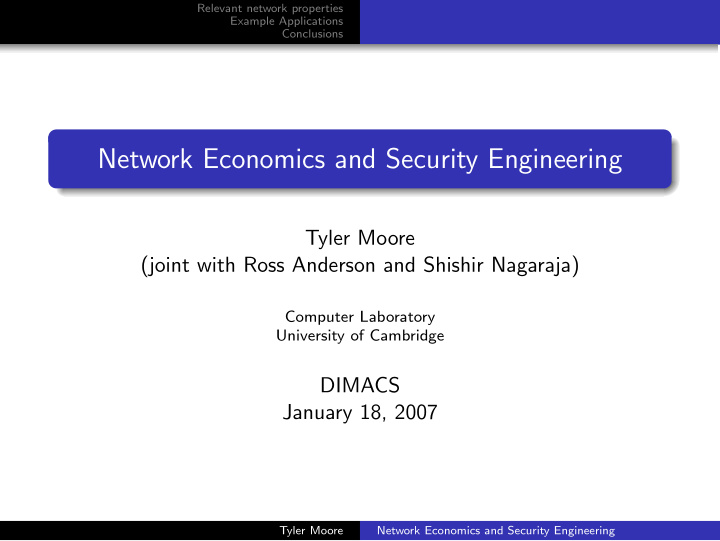



Relevant network properties Example Applications Conclusions Network Economics and Security Engineering Tyler Moore (joint with Ross Anderson and Shishir Nagaraja) Computer Laboratory University of Cambridge DIMACS January 18, 2007 university-logo Tyler Moore Network Economics and Security Engineering
Relevant network properties Example Applications Conclusions Outline Relevant network properties 1 Example Applications 2 Conclusions 3 university-logo Tyler Moore Network Economics and Security Engineering
Relevant network properties Example Applications Conclusions Motivation Many computing applications are network-based World-wide web Internet backbone Peer-to-peer networks Wireless sensor networks Social networks Network externalities matter: the decisions of others impact a user’s best response Interactions on these networks can be modeled as repeated games with evolving strategies Network properties influence dominant strategy outcomes university-logo Tyler Moore Network Economics and Security Engineering
Relevant network properties Example Applications Conclusions How do we represent a network? university-logo Tyler Moore Network Economics and Security Engineering
Relevant network properties Example Applications Conclusions Relevant network properties Network topology Network dynamics Adversarial model Different attacker goals Different attacker capabilities university-logo Tyler Moore Network Economics and Security Engineering
Relevant network properties Example Applications Conclusions Network topology Fully-connected graph Lattice Random graph (Erd˝ os-R´ enyi) Geometric random graph Scale-free degree distribution university-logo Small-world topology Tyler Moore Network Economics and Security Engineering
Relevant network properties Example Applications Conclusions Network dynamics Node mobility Lessens likelihood of repeated interaction Allows malicious nodes to maximize attack Churn Lessens likelihood of repeated interaction Makes punishment by exclusion difficult Makes Sybil attacks likely Intermittent connectivity Makes fair resource contribution difficult to establish Each of the above dynamics creates an informational asymmetry university-logo Tyler Moore Network Economics and Security Engineering
Relevant network properties Example Applications Conclusions Attacker goals Network partition Good strategy for a communications network, maybe not for a file-sharing network with built-in redundancy Disrupt operations of ‘normal’ protocols (e.g., message routing) Avoid detection and punishment Maximize eavesdropping capability university-logo Tyler Moore Network Economics and Security Engineering
Relevant network properties Example Applications Conclusions Attacker capabilities Global knowledge Powerful adversary can identify central nodes Local knowledge Random walk to infer network topology university-logo Tyler Moore Network Economics and Security Engineering
Relevant network properties Example Applications Conclusions Topology of covert conflict Scale-free network No application-level network dynamics (mobility, churn, etc.) Attacker goal: network partition Defender goal: maximize connectivity Attacker has global knowledge of network topology, defender has local knowledge Goal: study interaction between dynamic attack and defense strategy university-logo Tyler Moore Network Economics and Security Engineering
Relevant network properties Example Applications Conclusions Attack and defense mechanisms Attack mechanisms Remove nodes with high degree Remove nodes with high betweenness centrality Defense mechanisms Naive replenishment Localized rings Localized cliques university-logo Tyler Moore Network Economics and Security Engineering
Relevant network properties Example Applications Conclusions Attack under naive replenishment university-logo Tyler Moore Network Economics and Security Engineering
Relevant network properties Example Applications Conclusions Attack and ring/clique defenses university-logo Tyler Moore Network Economics and Security Engineering
Relevant network properties Example Applications Conclusions We would like to apply a similar repeated game simulation framework to other network applications Vary attacker models and goals Vary network topology and dynamics to study effect on security mechanisms Test viability of security mechanisms by varying strategies Promising applications Communications surveillance by a limited adversary(Danezis and Wittneben, WEIS 2006) Punishment mechanisms in decentralized computer networks university-logo Tyler Moore Network Economics and Security Engineering
Relevant network properties Example Applications Conclusions Punishment mechanisms in decentralized computer networks When devices misbehave, often there is no central authority available to identify and punish malicious behavior Solution: collective-decision mechanism Reputation system Blackballing with threshold voting Attacker goals Avoid punishment while misbehaving Abuse strategy to disconnect the network We have explored this space, and have proposed alternative mechanisms university-logo Tyler Moore Network Economics and Security Engineering
Relevant network properties Example Applications Conclusions Alternative mechanisms for addressing misbehavior Blackballing Nodes cast accusatory votes upon observing misbehavior; once enough votes are cast against a node, it is removed Reelection Devices cast positive votes affirming their friends; strangers only interact when they can demonstrate having a sufficient number of friends Suicide Nodes unilaterally decide when to remove a malicious node, but must sacrifice itself to demonstrate its sincerity university-logo Tyler Moore Network Economics and Security Engineering
Relevant network properties Example Applications Conclusions Open questions in the strategy space For blackballing and reelection, nodes can individually set thresholds according to their risk attitude Network topology and dynamics determine which strategy works best Scale-free degree distribution makes high-degree nodes immune to thresholds and low-degree nodes susceptible Likewise, suicide can be used to target high-value nodes Which strategy, if any, will dominate? university-logo Tyler Moore Network Economics and Security Engineering
Relevant network properties Example Applications Conclusions Potential game frameworks Hiding attacker Initially, half of nodes are assigned to each strategy Small fraction of nodes set as malicious (attacker goal: avoid punishment) Each round: Attack (some nodes misbehave) 1 Defend (implement strategy) 2 Adapt strategy if node identifies an unpunished neighbor 3 Active attacker Initially, half of nodes are assigned to each strategy Small fraction of nodes set as malicious (attacker goal: remove as many honest nodes as possible) Each round: Attack (malicious nodes falsely accuse honest nodes) 1 Defend (honest nodes try to punish attackers) 2 Probabilistically change strategy if node identifies unpunished 3 university-logo neighbors Tyler Moore Network Economics and Security Engineering
Relevant network properties Example Applications Conclusions Conclusions The structure and dynamics of networks can vary greatly It is not well understood how differences in network composition impact secure operation Simulations using a repeated game framework looks promising Much more work to be done! university-logo Tyler Moore Network Economics and Security Engineering
Relevant network properties Example Applications Conclusions More. . . http://www.cl.cam.ac.uk/~twm29/ university-logo Tyler Moore Network Economics and Security Engineering
Recommend
More recommend